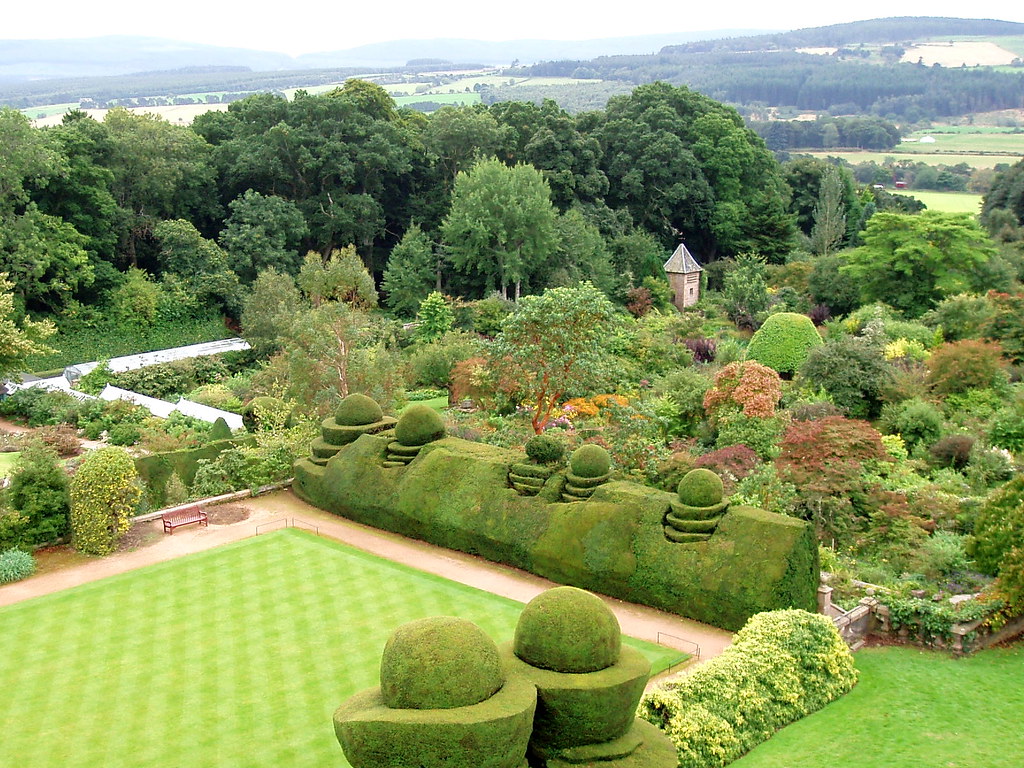Crathes Castle, five miles (8 km) east of Banchory in Aberdeenshire, Scotland, and fifteen miles (24 km) west of Aberdeen, is a classic Scottish tower houseCharacteristic style of Scottish castle building in the form of a tall tower, surrounded by one or more wings in L or Z-shaped floor plans in its later development.. Built by the Bell family of master masons for Alexander Burnett in the 16th century, it was held in the Burnett family for more than 350 years.
The castle and grounds are now owned and managed by the National Trust for Scotland, and are open to the public. The trust describes Crathes Castle as “an intricate maze of turrets, towers, oak panels and painted ceilings, many of which survive beautifully to this day”.[1] Crathes Castle is a Category A listed buildingStructure of particular architectural and/or historic interest deserving of special protection..[2]
The world’s oldest known lunar calendar was discovered in the grounds in 2004.
History
Robert the Bruce granted land in Aberdeenshire to the Burnett family in 1323, along, so it is said, with the Horn of Leys – the laird’s badge of office as the Royal Forester – which sits above the fireplace in the castle’s Great Hall;[1][3] the Burnett’s first home was on the Island of Ley.[2] Alexander Burnett began the construction of the castle in 1553, and it was completed some time before 1596, when a date panel suggests that some improvements had been made.[4]
Interior
The castle contains a collection of early portraits of the Burnett family, as well as some of its original furniture.[3]
Garden and grounds
Crathes would originally have had a simple kitchen garden, but during the 19th century Sir James and Lady Burnett developed that into the walled garden as seen today. Ancient topiary hedges of Irish yew dating from 1702 separate the gardens into eight themed areas, following the Arts and Crafts approach to garden design.[5] There is also a grass croquet court at a higher terraced level within the walled garden.[6]
Mesolithic calendar
During excavations in a field at Crathes Castle in 2004 a series of pits were unearthed, probably dating from about 8,000 BCE. The find is believed to be the world’s oldest known lunar calendar, predating by thousands of years previously known time-measuring monuments in Mesopotamia. Known as Warren Field, the site was discovered as unusual crop marks seen from the air during a survey by the Royal Commission on the Ancient and Historical Monuments of Scotland. Its significance lies not only in its early date, but in that it was constructed by hunter-gatherers.[7]
Green Lady’s Room
Crathes Castle is reputedly haunted by the ghost of a young woman who crosses the floor of the Green Lady’s Room to the fireplace, where she stoops to pick up an equally ghostly infant. The reports were given some credence by the discovery of the skeletons of a young woman and a baby found beneath the fireplace while renovations were being carried out.[8] Queen Victoria is reported as having seen a “green mist” floating across one of the rooms, which swept up a ghostly child before disappearing into the fireplace.[9]



